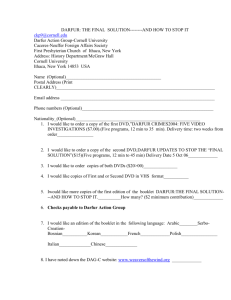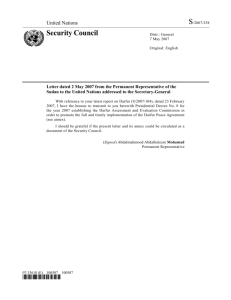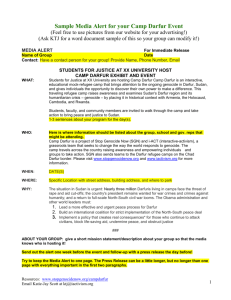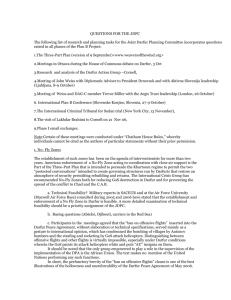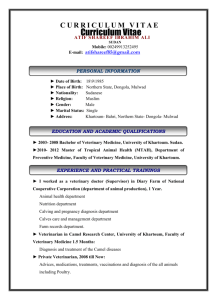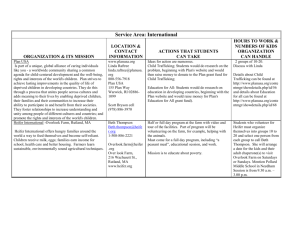the sudanese endgame - Weavers of the Wind
advertisement
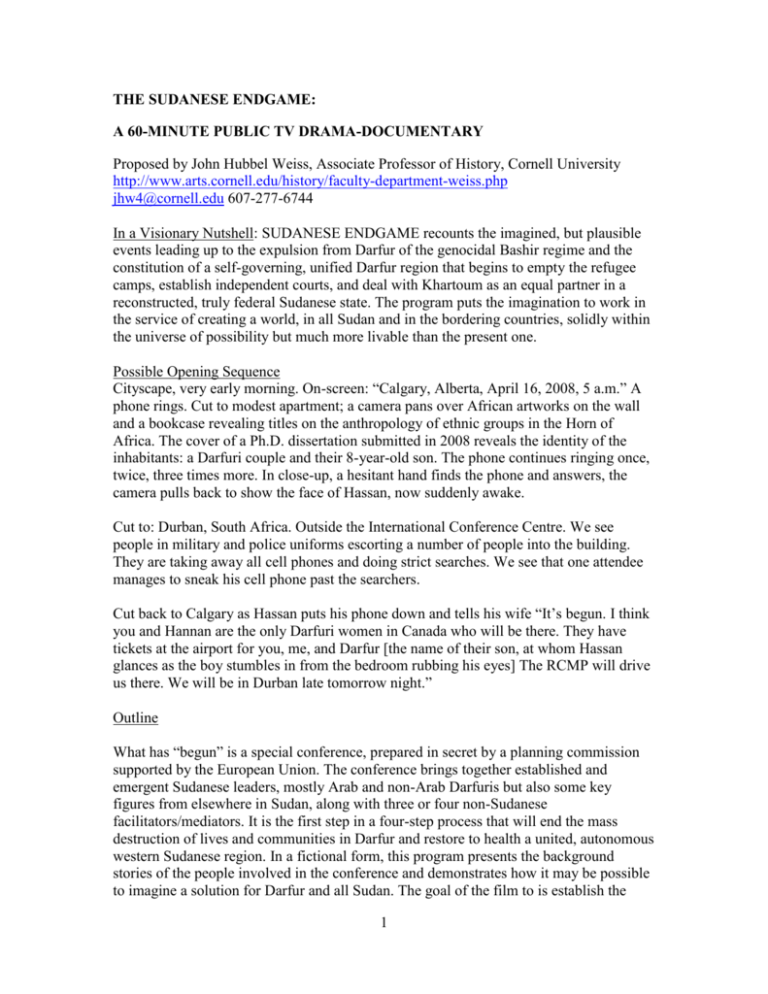
THE SUDANESE ENDGAME: A 60-MINUTE PUBLIC TV DRAMA-DOCUMENTARY Proposed by John Hubbel Weiss, Associate Professor of History, Cornell University http://www.arts.cornell.edu/history/faculty-department-weiss.php jhw4@cornell.edu 607-277-6744 In a Visionary Nutshell: SUDANESE ENDGAME recounts the imagined, but plausible events leading up to the expulsion from Darfur of the genocidal Bashir regime and the constitution of a self-governing, unified Darfur region that begins to empty the refugee camps, establish independent courts, and deal with Khartoum as an equal partner in a reconstructed, truly federal Sudanese state. The program puts the imagination to work in the service of creating a world, in all Sudan and in the bordering countries, solidly within the universe of possibility but much more livable than the present one. Possible Opening Sequence Cityscape, very early morning. On-screen: “Calgary, Alberta, April 16, 2008, 5 a.m.” A phone rings. Cut to modest apartment; a camera pans over African artworks on the wall and a bookcase revealing titles on the anthropology of ethnic groups in the Horn of Africa. The cover of a Ph.D. dissertation submitted in 2008 reveals the identity of the inhabitants: a Darfuri couple and their 8-year-old son. The phone continues ringing once, twice, three times more. In close-up, a hesitant hand finds the phone and answers, the camera pulls back to show the face of Hassan, now suddenly awake. Cut to: Durban, South Africa. Outside the International Conference Centre. We see people in military and police uniforms escorting a number of people into the building. They are taking away all cell phones and doing strict searches. We see that one attendee manages to sneak his cell phone past the searchers. Cut back to Calgary as Hassan puts his phone down and tells his wife “It’s begun. I think you and Hannan are the only Darfuri women in Canada who will be there. They have tickets at the airport for you, me, and Darfur [the name of their son, at whom Hassan glances as the boy stumbles in from the bedroom rubbing his eyes] The RCMP will drive us there. We will be in Durban late tomorrow night.” Outline What has “begun” is a special conference, prepared in secret by a planning commission supported by the European Union. The conference brings together established and emergent Sudanese leaders, mostly Arab and non-Arab Darfuris but also some key figures from elsewhere in Sudan, along with three or four non-Sudanese facilitators/mediators. It is the first step in a four-step process that will end the mass destruction of lives and communities in Darfur and restore to health a united, autonomous western Sudanese region. In a fictional form, this program presents the background stories of the people involved in the conference and demonstrates how it may be possible to imagine a solution for Darfur and all Sudan. The goal of the film to is establish the 1 plausibility and feasibility of these actions. The four steps imagined as constituting one possible solution will be established early in the film by references to the four-step Afghan precedent that began with a similar assembly of leaders in Bonn, Germany, in November 2001. At the end of the hour, when all the back stories have been woven together, we see the opening gavel being struck and are left waiting for the actual meeting to take place. Initial List of Characters The following characters are the sources of the principal back-stories that must be woven together in order to make a successful argument that the conference can be the beginning of a plausible rescue sequence. They are based on real people. Each plays a crucial role in one or more of the “obstacle scenes” that will move the narrative and generate dramatic tension. 1. Hassan, a leading Darfuri opposition figure. Now a Canadian citizen living in Calgary, he was formerly a high school teacher in El Fashir arrested for his open opposition to the military regime of Omar el-Bashir, which seized power in 1989. He has legal as well as pedagogical training and is now completing his Ph.D. in cultural anthropology at York University. Short of money, he was forced to leave Toronto to take a job as a laborer in job-rich Calgary. He helped to found one of the two original armed resistance groups, the Sudan Liberation Army. He is one of the intellectual centers of the Darfuri Diaspora.The film shows that he has been consulted extensively by a Joint Darfur/Sudan Planning Commission established by the European Union. (The character is a composite of two real Canadian Darfuris known to the present writer.) 2. Sakina, Hassan’s wife. An outgoing, energetic, and engaging woman several years younger than G. She manages to be both thoroughly Canadian and thoroughly Darfuri. She is especially fond of Darfuri and other Sudanese music and maintains a large collection of tapes and CDs. Like her husband, she is fluent in Arabic, English, and Fur. She has been working as a retail salesperson while Hassan finished his degree, but that job and her parenting of their child, Darfur, have not been enough to contain her energies and communication/leadership talents. She has become active in an international aid NGO called Waging Peace. (character based on the real wife of one of the persons on whom Hassan is based) 3. Darfur, a wiry, energetic, outgoing, inquisitive 8-year-old, born in Toronto, who is being raised to speak English, Arabic, and Fur. His parents are becoming less and less able to hide things from him by switching languages. They now just select carefully words to spell out. (The son of Sakina and actually named Darfur) 4. Sahara Abdel Rakman. An English teacher in a small town in northern Darfur, she lost all her family, her friends, her home, and her possessions when the janjawiid militias, backed by Government of Sudan (GoS) bombers, raided the town in February 2004. Interviewed on film two days later by Philip Cox, the first journalist to enter Darfur after the genocide began, she wound up in a camp in Chad, then traveled to Nigeria and to Libya, finding a way to ride with the entourage of the JEM rebel movement. She then became a widely known figure in the world of Chad 2 refugee camps, pushing hard to raise money to get books for a school she founded in one of the camps. In the film the Joint Darfur/Sudan Planning Commission has identified her leadership capabilities. She will be extracted from her camp by a special detachment of Rwandan troops and placed on a plane to Durban. (To meet Sahara, go to YouTube and select keywords Sahara-Darfur. To learn about her project, Refugee Education After Conflict Trust, click on www.reactweb.org). 5. Bakri Adam, secretary-general of the Darfuri student union in Khartoum. Arrested several times by the government, he spend two months in one of Khartoum’s notorious “ghost houses,” the regime’s torture centers. His cell phone is monitored. He has been told that any more political activity will get him a capital sentence. He continues to report to his international contacts by email. (Composite character. The Sudanese intellectual who was tortured in a “ghost house” now resides in Amherst, Massachusetts. The Darfuri student union leader in Khartoum was still alive and out of prison as of November 2007) 6. Modibu, venerable supreme leader (nazir) of the southern Rizeigat, the most important single Arab group in Darfur. The GoS have always considered him dangerously independent, partly because of his refusal to cooperate with them in attacking non-Arab tribes. They have twice tried to have him assassinated. (Modibu is now very old and probably couldn’t really appear as himself in the program; a composite of several Arab leaders could be used to create this character.) 7. Mudawi Hilal, leader of a militia (janjawiid) group, part of whose members have been incorporated into a “Border Intelligence Unit.” Fond of reciting passages from the Arab supremacist “Qureish 2” manifesto as they were a muezzin’s calls to prayer, he carries, strangely, an American M-4 assault rifle instead of a Kalashnikov. This composite character is portrayed as the nephew of the real Musa Hilal, leader of the Um Jalul Arabs and self-appointed chief of all the janjawiid. Musa currently serves as special advisor to Sudanese President Omar al-Bashir. 8. Salah Abdallah Ghosh. Minister of State Security and Intelligence in the GoS. Ghosh is the Heinrich Himmler of the Darfur Holocaust, directing the security apparatus in Darfur and playing the most powerful role in setting overall policy for Darfur “counterinsurgency” and “resettlement.” At the same time, he is highly valued by the CIA as the source of what the American government claims to be --with considerable exaggeration, according to my sources--extremely useful intelligence regarding al Qaeda operations throughout the world. The American Government’s failure to authorize any genocide-stopping measures that might seriously annoy the GoS may be explained by its fear that such robust measures would reduce or cut off its counterterrorist intelligence feed from that regime. American policy has thus been reduced to symbolic, patently futile, deliberately limited, risk-averse, calculatedly underresourced actions. 9. Bolad Machar Deng, colonel in the Sudanese Peoples Liberation Army and elected official in the parliament of the Government of Southern Sudan. He was educated at Grinnell College in the United States and also attended the Command and General Staff College at Fort Leavenworth, Kansas. He presided at meetings between Darfur rebel leaders and SPLA officers in 2007 and 2008. (Composite character) 10. Coalition Commander. A high-ranking military officer who commands the coalition of forces who will support the Durban meeting operation. His parents were refugees 3 from the Nazi genocide who fled to Khartoum. He was raised partly in Khartoum and speaks Arabic as well as accented English. The film will show that he had met Bolad Machar Deng several years before when both were part of the contingent of foreign officer-students at CGS College. His initial ops order is based on information supplied by the Joint Darfur/Sudan Planning Commission referred to above. His air and ground units will carry out the warning or retaliatory actions that will prevent the GoS from blocking the Durban meeting. He will also command the units tasked with supporting the interim regional administration which emerges from that meeting. Only hints will be given about his nationality or the country of origin of the troops he will command. (Composite character) 11. Lakhdar Brahimi. Algerian diplomat and longtime UN official. Key facilitator of the assemblies of Afghan leaders (partly elected, partly selected) that led to the successful creation of a constitutional government after an Interim Administration was established in a week-long meeting in Bonn, Germany. In this film Brahimi, who has been interviewed at length by the present writer, is called upon to repeat his successful performance, mutatis mutandis, for Darfur. (Brahimi has serious eye trouble right now and may not be able to participate in person, but we know the identity of his two key assistants at Bonn. His function in the plot may also be fulfilled by invoking his name and referring to the success of the Afghan meetings, which the impact of the 2003 invasion of Iraq has caused to be forgotten despite reference to it in Khaled Hosseini’s well known novel The Kite Runner) Objective In making this program, CBC production team’s task will be to portray the back stories in such a way that an outline of the complexities of the situation in Darfur becomes clear to the audience while simultaneously making the proposed solution plausible – which we believe it is. The program ends as the gavel comes down actually opening the meeting in Durban. The audience has seen the problems and also seen the proposed solutions. With this program, whose policy aspects have been discussed extensively with people involved directly in the struggle, with academic experts, and with policy-makers themselves, we could bend history. Associated Website A website will take each issue related to the Darfur genocide, and each backstory, and provide information enabling the reader to explore the matter in depth. (The domain <www.sudaneseendgame.com> was available a/o 2 March 08) For current reference, see www.weaversofthewind.org and www.sudanreeves.org. 4 A Sample of More Sequences and Scenes Considered Important for Weaving Together the Backstories and Portraying the Overcoming of Obstacles to a Successful Outcome 1. The fate of Bakri Adam. The GoS agent’s warning to Adam introduces the matter of overcoming Khartoum’s determination to stop or undermine any meeting that could result in Darfuris’ political empowerment, develop their capacity to make alliances with the South, or arrange the intervention of outside armed forces. The Bashir regime knows that such intervention by outside forces could be tasked to support removal of GoS security/intelligence units from the region and the enforcement of the ordinances of the interim regional administration and, later, more representative and accountable governing bodies. The timing of actions by the forces supporting the Darfuris is a crucial matter that will have been worked out in detail by the Joint Darfur/Sudan Planning Commission. The identity of these supporting forces is also something that will be considered crucial. Matters of plausibility and feasibility will naturally be raised here by those committed to current policies and recommendations. I would argue that the film needs only to establish that the troops and aircraft shown are equipped with the latest weapons and communications gear, that they come mostly (but not entirely) from non-African countries, and that they possess effective media relations and public information capabilities. Aircraft could be shown operating from an existing or quickly constructed air base in Chad with supporting AWACs (long-distance surveillance) planes coming from elsewhere (Djibouti, Red Sea, etc.). But units not from Chad or France could use this base. They already have used the existing base at Abéché. A. April 14, 2008. Long shot panning across the Khartoum skyline.We see the modern skyscrapers and other gleaming new buildings lining the Nile reflecting the capital’s oilborne prosperity.[1] The viewer is brought to compare this scene to the often-filmed destitution of the wind-blown desert refugee camps, or the poverty and terror of the prison-like “peace villages” housing Southern Sudanese refugees from the civil war to be found not far from the outskirts of Khartoum. Cut to: A new, luxurious indoor mall in the heart of the city, where four young men are sitting on low benches sipping coffee. One is wearing a Sudanese army officer’s uniform. One can imagine a conversation between this officer and Ibrahim Bagal (see above). The settings tell half the story (luxurious mall, gleaming buildings juxtaposed with refugee camps) while the officer warns Ibrahim, allowing the viewer to see the political and social issues. B. April 15, 2008 The Ambassador representing the rescuing coalition delivers the warning to President Bashir: any attempt to threaten, arrest, or kill those who have been summoned to the Durban meeting will trigger the imposition of an “unacceptable cost” on the government. On that same day the summoning begins, pre-arranged in the cases of some prospective attendees. Since little difficulty was anticipated in extracting Hassan, Sakina, and their son from Canada, they could be escorted from their apartment on the 16th, as indicated in the suggested opening scene. Also on that day, the “exemplary exercise of air power” could take place as described in 5 S2. below. The GoS would then have to decide whether or not they would “approve” the attack on the criminal gang, buying into the intervening coalition’s cover story. Bakri Adam will be sought by a squad of special ops troops who search Khartoum and Omdurman. The scene would show them inspecting known “ghost houses” and locations on university campuses. C. April 18, 2008 Adam enters the Durban conference center. He embraces Hassan, the Darfuri-Canadian who had sent him money and had otherwise supported his opposition activities. 2. The story of Sahara Rakman. A. The opening scene of her story will be the attack on her village mentioned in her character bio. Readers of this document who have seen THE CONSTANT GARDENER will remember the dramatic visual impact of the militia attack on an encampment in South Sudan that occurs near the conclusion of the film. Those militias rode in on horseback. Add janjawiid riding in machine-gun –mounted land cruisers. Then insert shots of helicopter gunships attacking civilians on the ground as in BLOOD DIAMOND and you have the basis for the scene. B. Her intervening travels and establishment of schools in the refugee camps, activities that help to show her as an emerging figure in the newly identified Darfuri leadership class, can be shown in short scenes of her travelling and speaking to officials and teachers. C. Sahara’s extraction from her refugee camp to attend the meeting will illustrate the overcoming of another key obstacle to the rescuing coalition’s implementation of the Afghan model, the control of personnel and information into and out of the camps by Sudanese agents. Her extraction will be accomplished by a squad of aggressive-looking and battle-hardened Rwandan troops, detached from the distrusted and operationally limited UNAMID “hybrid’ corps (mostly African Union troops now wearing UN insignia) , it is hinted, by an arrangement between the local UNAMID commander and the Coalition Commander. 3. Mudawi Hilal’s Road to Durban A. Introduced in the scene of the attack on Sahara’s village will be the militia leader Mudawi Hilal, seen directing the trucks, gunships, and horsemen. Since Mudawi will be shown arriving at the meeting, we will be able to pose the question of how perpetrator and victim can come to face each other across a table, something my daughter Amity, an aidworker in Rwanda, witnesses every day. B. A variation, esp. useful if we want to limit the number of speaking characters, is to show the alienation of Mudawi Hilal from his GoS mentors and his 2007 alliance with his former opponents in the armed rebel groups. Such alienation and regrouping has recently been occurring on a wide scale in Darfur, despite the efforts of Arab supremacist groups and certain Army officers to maintain the ethnic cleansing project. C. Mudawi’s arrival at Durban. It is he who smuggles the cell phone into the meeting. Will he use it to take orders from his uncle about how to subvert the meeting or will he 6 use it to contact other janjawiid leaders and ask to be their representative? 4. Bolad Machar Deng’s Path to Durban Bolad Deng’s story will address the crucially important question of the connection between the Bashir regime’s relationship to the South and its destruction of Darfur. The film will reflect the willingness of most leaders of the South to put aside their resentment of recruited Darfuri soldiers’ participation in the war against them. It will show as well the Southerners’ recent attempts to assist Darfur in developing a skilled, accountable political class that could produce leaders who could work with other Sudanese to produce a regional administration that combined functional capability and legitimacy. It will be made clear through incidents in Deng’s backstory that a credible threat of attack from the South’s military arm, the SPLA, could serve as another powerful deterrent to Khartoum’s attempts to block the Durban meeting. 5. Security for the meetng’s attendees: The warning to the GoS. For anyone attempting to implement some version of this film’s solution, a major challenge will be finding a will and a way to impose, or produce a credible threat to impose, an unacceptable cost on Khartoum for any attempt to follow past practice by threatening, arresting, or killing anyone within their reach who might attend the Durban meeting. There is also the major challenge of finding a way to support any interim administration emerging from the meeting in its accession to power and establishment of order in their newly restored region. Two solutions: S1.Shortly before the beginning of the attempt to extract attendees and transport them to the meeting (or immediately upon learning that the GoS has learned of the plans for the meeting), a no-fly zone over Darfur is declared. (The GoS shipment of aircraft to Darfur and its use of them in attacking villages already constitute direct violations of two sets of UN ordinances and declarations). At the same time, the GoS is warned that any attempts to threaten, arrest or kill will bring the neutralization of their air assets in Darfur. In this scenario the elimination of the fighter-bombers and helicopter gunships currently stationed in Darfur is assumed to impose an unacceptable cost. To this list of assets might be added the three tank platoons sent to West Darfur as reported in the New York Times of 2 March 2008. Ground attack aircraft such as the American A-10 Thunderbolt can destroy tanks with a high degree of reliability. The Kosovo precedent suggests, moreover, that if the GoS persists in its meetingobstruction tactics, other high-value targets would be attacked. In this scenario the attacks on GoS aircraft and airfields would be done immediately after receiving confirmation and evaluation of the threat to Adam or any other obstructive action. S2. A solution that could accomplish the restoration of Darfur with minimal violence would entail warning the GoS in a different way. After the crushing defeats inflicted on his forces in the fall of 2006, Bashir purged 3000 officers and a larger number of enlisted men. Many had refused to fight and whole battalions had mutinied. So what happened to these soldiers? According to high-level sources substantial numbers of them formed large, roving criminal gangs. The instrumentalization of turbulence and 7 chaos in Darfur and in other regions that Sudanese regimes have treated as internal colonies has been a major part of Khartoum’s policy from the beginning. So, in a sense, Bashir and Co. could only profit from this anarchy. But, officially, no one approves of this disorder and insecurity. Thus an attack upon a criminal gang of some size by UAVs (such as the Predator) and ground attack aircraft (such as the A-10 Thunderbolt, of which some 350 are in the American inventory, and might be “leased” to the implementing antigenocide coalition) could be conducted shortly before the launching of the meeting. Khartoum would thus be warned The headquarters of EUFOR or whatever ad hoc coalition was supporting the Darfuris could then announce that this attack, which involved incursions into Sudanese air space, was carried out at the request of UNAMID and with the approval of the Government of Sudan. The Bashir regime would then be faced with two options: 1. They could thank the implementing coalition for helping to punish killers and looters. 2. They could denounce the invasion of sovereign Sudan by the white Christian Zionist imperialist colonialist capitalist comboys. In doing the latter, however, they could not avoid revealing to the street crowds assembled to hear Bashir’s bloodthirsty rhetoric that they really couldn’t prevent such violations of their sovereignty. In either case, the warning that obstruction of the Durban meeting would bring a loss of their air assets would follow. We would estimate that the odds would be even that Khartoum would then quietly tell the warning coalition that they would cooperate in allowing the meeting AND even in the implementation of its conclusions. They would calculate that they could use all their years of experience in subverting, deceiving, reneging, bribing, and opponent-dividing to bring Darfur back under their control in a very short time. They have made autonomy agreements and then sabotaged them at least twice before. Finally, a producer’s perceived need for visually striking, non-talking-head scenes could be satisfied by an A-10 attack on the bandit gang or an A-10 attack on the A-5 FanTan fighter-bombers now parked at the El Fashir airfields, the Mi-24 helicopter gunships now refueling at their Geneina base after their recent bloody attacks on three undefended towns, or the GoS’ tank units that have just taken up positions in Darfuri cities. Should budget and time constraints prevent the staging of such an attack, one of the characters could narrate it, having been a witness. [1] See for example the images at http://images.google.com/imgres?imgurl=http://www.skyscrapernews.com/images/thumb s/715SudansFutureLookstoAlsunutKhartoum_pic3.jpg&imgrefurl=http://www.skyscrape rnews.com/news.php%3Fref%3D715&h=50&w=100&sz=8&hl=en&start=16&tbnid=9_ CmtdGmbLvtWM:&tbnh=41&tbnw=82&prev=/images%3Fq%3DSudanese%2Bskyscra pers%2BKhartoum%26gbv%3D2%26hl%3Den%26client%3Dfirefoxa%26rls%3Dorg.mozilla:en-US:official%26sa%3DG. Click on to enlarge the three shots of the Alsunut development on the right side of the page. 8
